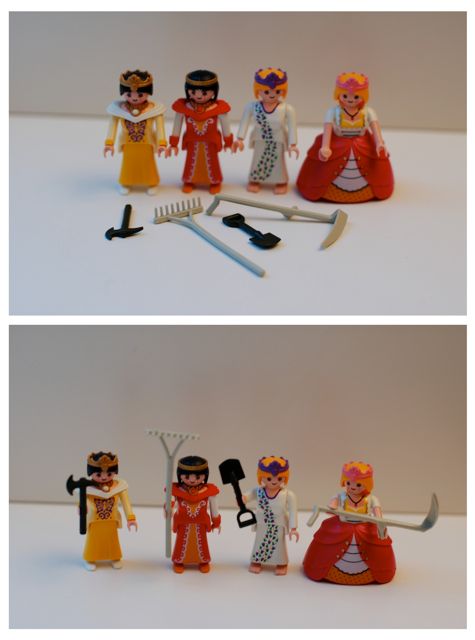


Materials and Methods
The pictures can be downloaded in a compressed file by clicking here. There are currently more than 70 pictures, depicting different kinds of people, animals, plants, artifacts, and situations. They are in a single folder, ordered sequentially. This is meant to make it easier to present them as a slide show on a computer, and the numbers make it easier to refer to them in field notes. Some examples appear to the right.
The pictures are meant to test primarily for distributive versus non-distributive readings, involving universal quantifiers (all, each, every) interacting with indefinites or existential quantifiers. For instance, in the three pictures to the right, sharks are attacking people: four sharks attack a single person; each of four sharks attacks a different person; and a single shark attacks three people. The idea is to test, first, whether a sentence like Every shark is attacking someone can be distributive, with the subject quantifier distributing over the object. In English, that sentence can truthfully describe both the top picture and the middle picture. Because it can describe the middle picture, we know that quantifiers like every shark can distribute over (take scope over) an indefinite. Once it has been established whether a given quantifier can distribute, then the grammatical roles can be reversed: A shark is attacking every person. Most speakers of English judge this to be true of both the middle picture and the bottom picture, but some judge it to be true only of the bottom one. For those speakers, a universal quantifier as object cannot take scope over and distribute over an indefinite in subject position.
Note that the pictures can be described in many different ways, depending on what the researcher wants to investigate. Actives versus passives can be tested, for instance, with the exact same pictures (Someone is being attacked by every shark, true only of the top picture). Different quantifiers and quantificational expressions can be used: every person versus all (the) people, each person, and every person, a person versus everyone, someone. Here are some contrasts that are meant to be tested:
- Eventives versus statives: sharks attacking, people catching fish, people picking things up; versus people sitting or holding things;
- Arguments versus adjuncts (or direct/indirect objects versus PPs): people holding things versus birds perching in trees or lanterns hanging in trees;
- Ditransitive constructions: people feeding fish to sharks, a woman giving girls dogs.
Methodology


- The task here is a truth-value judgment task, in which a sentence is judged as true or false of a given picture. Speakers are generally quite able and willing to do this task.
- A few pictures are thrown in to elicit negative responses. For instance, in the picture to the right, there are four women riding horses, and one horse with no rider. Just to verify that speakers are willing to say no, you can give the sentence Every horse has a rider, or A woman is riding every horse, and the answer should be "no" or "false."
- These same pictures can also be used to create a contrast for the felicitous use of a universal quantifier. For instance, the picture at right can be presented, paired with the sentence A woman is riding every horse. This should be judged to be false. Then the picture with all the horses being ridden can be presented (it's back on the Home page); in contrast with the picture at right, where not all the horses are being ridden, it may be more felicitous to use the universal quantifier, with the intended inverse scope.
- These pictures can also be used to test for symmetrical readings. In the horse-riding picture at right, some speakers will reject Every woman is riding a horse as an accurate description of this picture, because there is a horse that is not being ridden.
- Some of the pictures are two-step pictures that are intended to depict more dynamic events. The pictures are always a "before" and "after." In the one at right, the test sentence is meant to be something like A woman picked up every tool.
- You can also present a sentence and ask the speaker to pick which picture fits it best. For instance, of the three shark pictures above, you could present the bottom two, and ask which picture fits the sentence A shark is attacking every person. This will not determine whether a given interpretation is grammatical, just what interpretation is most salient. However, many speakers are quite willing to say things like, "No, that sentence only describes this picture, not that one."
- I always present each picture first and ask the speaker to describe it. Typically this will produce something like "I see four sharks attacking a man." You can then alter the sentence they produced to elicit judgments on the quantifiers you are interested in.
- In English, it is a well-established finding that not every speaker will assent to inverse scope readings of sentences like A woman is riding every horse, although around 70 percent of respondents will. It is a good idea to get data from as many speakers as possible (not always possible or practical in the field, however).
- These particular pictures were first created for Passamaquoddy-Maliseet, an Algonquian language that makes an important animate-inanimate distinction. Hence some of the pictures will be redundant in some other languages (bottles are animate but lanterns are inanimate in Passamaquoddy-Maliseet, for instance). We attempted to create many different situations involving different kinds of people, animals, and artifacts; only a subset of them will be relevant to any given language. It is certainly not necessary to use all the pictures.
Scope of Negation
Some of the pictures were created to tell stories. There are three sequences of these: pictures 041 through 044 ("Catches None"); 045 through 050 ("Catches All"); and 045 through 048 plus 051 ("Catches Some"). In "Catches None," a man goes fishing but catches nothing; in "Catches All," he catches all the fish and then leaves; in "Catches Some," he catches most but not all of the fish, and then leaves.
Here are the basic scripts for the stories:
Catches None:
- (041) Here's a man who goes fishing. First he tries casting his line on one side.
- (042) He doesn't catch anything, so he tries the other side.
- (043) He still hasn't caught anything, so he sits down to fish.
- (044) Finally he leaves, empty-handed.
Catches All:
- (045) Here's a man who goes fishing.
- (046) He catches one fish and puts it in his barrel.
- (047) He catches a second fish and puts it in his barrel.
- (048) He catches a third fish and puts it in his barrel.
- (049) He catches the fourth fish and puts it in his barrel.
- (050) Then he goes home with his fish.
Catches Some (first four as above):
- (045) Here's a man who goes fishing.
- (046) He catches one fish and puts it in his barrel.
- (047) He catches a second fish and puts it in his barrel.
- (048) He catches a third fish and puts it in his barrel.
- (051) He goes home, leaving one fish uncaught.
These stories are meant to test whether an indefinite can take scope outside negation or not. The test sentence would be The man didn't catch a fish. If that is only true of "Catches None," then the indefinite cannot take scope over negation. If it is also true of "Catches Some," then the indefinite can take scope over negation ("there is a fish such that the man did not catch it"). This could be useful if a language has differential object marking, or some way of marking specificity. (This story was taken from Irene Krämer, 1998, "Children's Interpretations of Indefinite Object Noun Phrases: Evidence from the Scope of Negation." In R. van Bezooijen and R. Kager, Linguistics in the Netherlands, Amsterdam: John Benjamins.)